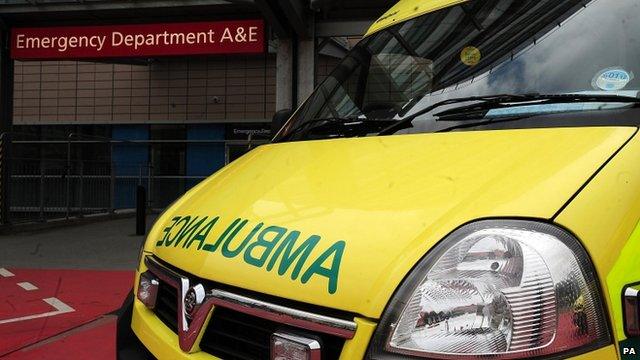Patients 'face long queues in ambulances outside A&E'
- Published

About 300,000 ambulances were left queuing outside hospitals last year with patients waiting to be seen in A&E, according to research by Labour.
The longest recorded delay was more than eight hours, despite the 15-minute nationally agreed standard.
Handover delays typically happen when emergency departments are too busy to safely accept new patients.
The Department of Health said long waits were "unacceptable" but numbers had fallen over the past year.
Labour obtained data from all ambulance trusts in England under the Freedom of Information Act.
The investigation found 279,207 ambulances were delayed for more than half an hour, and a further 30,601 reported waits lasting over an hour.
Urgent calls
Figures from the West Midlands revealed the longest single wait at eight hours 11 minutes.
In the south west of England, one patient was in a queue for seven hours 32 minutes. In London the longest delay was six hours 10 minutes.
Though national guidelines say the handover process should take no longer than 15 minutes, in every ambulance trust in the country some patients waited more than an hour.
There are a few situations where a wait can be justified on clinical grounds - a limited number of patients may have treatment in the vehicles.
But long delays can hold up hospital care and may prevent ambulances from being available for other urgent calls.
NHS England said delays over the winter period - when pressures are at the highest levels - had fallen by 30% between 2012-13 and 2013-14.
And a Department of Health spokesperson told the 91ČČąŹ: "Long handovers are completely unacceptable.
"We are providing extra support, including ÂŁ28m for ambulances from funds already given to the NHS this year, to keep services sustainable year-round."
'Wrongly held'
Jamie Reed, the Labour shadow health minister, said: "Thousands of vulnerable people, many of them elderly and frightened, are being wrongly held in the backs of ambulances because hospitals don't have the space."
The number of visits to A&E units has been rising for a number of years. There were more than 14.2 million attendances last year - up 1.4% in two years.
Dr Cliff Mann, of the College of Emergency Medicine, told the 91ČČąŹ: "It is our view that emergency departments should have sufficient capacity to meet demand, and that means ambulances should be able to transfer patients into departments immediately on arrival.
"It has been clear that this has been difficult to achieve at times. This problem is symptomatic of the pressures emergency departments are facing."
- Published3 June 2014
- Published9 December 2013